TUCSON, Ariz. — What will the world look like in 1,000 years? One camera is hoping to capture the moment for your descendants — all in one single photo. In the serene landscape of Tumamoc Hill, a unique project, known as the Millennium Camera, is set to capture the evolution of Tucson, Arizona, over the next thousand years.
Unlike traditional cameras, the Millennium Camera employs a simplistic design for longevity. Light enters through a pinhole in a 24-karat gold sheet and imprints on a special surface inside a copper cylinder. This surface is coated with rose madder, a type of oil paint pigment, which will gradually fade under sunlight over centuries. In a millennium, this process will reveal an image of Tucson’s transformation through time.

Experimental philosopher Jonathon Keats, a research associate at the University of Arizona College of Fine Arts, is the brainchild behind the Millennium Camera. He and his team from the Desert Laboratory have installed this camera with a viewpoint overlooking the Star Pass neighborhood, encouraging hikers to reflect on what lies ahead.
“Most people have a pretty bleak outlook on what lies ahead,” Keats says in a university release. “It’s easy to imagine that people in 1,000 years could see a version of Tucson that is far worse than what we see today, but the fact that we can imagine it is not a bad thing. It’s actually a good thing, because if we can imagine that, then we can also imagine what else might happen, and therefore it might motivate us to take action to shape our future.”
The concept behind this long-term photographic project challenges conventional methods. Typical cameras capture images quickly, using chemical reactions or digital processes. However, these methods wouldn’t endure a thousand years, nor would future humans necessarily have the means to interpret such images. The Millennium Camera, through its slow-fading pigment, bypasses these limitations.
“Let’s take a really dramatic case where all the housing is removed 500 years in the future,” explains Keats. “What will happen then is the mountains will be clear and sharp and opaque, and the housing will be ghostly. All change will be superimposed on one image that can be reconstructed layer by layer in terms of interpretation of the final image.”
Beyond documenting the past, the project aims to inspire current generations to consider their impact on the future. It’s not a commentary on urban development, but rather an invitation to ponder and discuss our role in shaping the environment.

To ensure a broad perspective, Keats collaborated with local experts, including Clark Reddin, the Desert Laboratory’s director of operation, and Robert Villa, community outreach assistant. Both have deep ties to Tumamoc Hill. Their choice of location reflects the hill’s historical significance and its role in connecting people with their environment.
Keats plans to expand this project, with another camera on Tumamoc Hill facing a different direction and additional installations at the Santa Rita Experimental Range and globally, in places like Chongqing, China, and Griffith Park in Los Angeles.
“This project depends on doing this in many places all over the world,” concludes Keats. “I hope this leads to a planetary process of reimagining planet Earth for future generations.”
